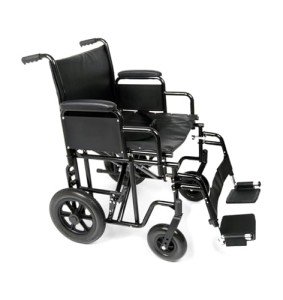Bariatric Wheelchair Seat Width
Seat Width
Having the right seat width is very important to wheelchair users who invest longer durations in their chairs. Too narrow a seat will trigger pressure on the hips and thighs which might cause sores or pressure points. Having too broad a seat can also make it challenging for the user to reach the hand rims to move themselves or maneuver in small areas.
To measure the right seat width an individual would sit on a chair typically and have their measurement taken throughout their lap at the widest point which is typically their hips. A wheelchair determining tape can be used to determine this, however a yard stick is chosen as it avoids people from wrapping the tape around their hips which would give an incorrect result.
The standard wheelchair seat width is 16" (narrow grownup), 18" (basic grownup), and 20" (large adult). For bariatric patients, a 24" seat is offered. This durable extra broad bariatric wheelchair from Medline features swing-away footrests, a carbon steel frame with rust- and chip-resistant chrome plating, and easy-to-clean vinyl upholstery. It has a weight capacity of 500 pounds.
Seat Depth
Generally, the seat depth of a bariatric wheelchair was added 2" to the measurement taken at the user's largest point (usually their hips). This was implied to accommodate additional layers of clothing that may be used throughout winter. However, this practice is becoming less typical as wheelchair users are able to invest more time inside and are not wearing long coats. This makes the seat depth of a chair lesser when picking a bariatric wheelchair. However, it is still essential to select an option that uses adequate assistance for larger users.
bariatric wheelchairs folding extra broad bariatric manual wheelchair features a comfortable 24" seat width and a durable slide tube silver vein frame. It also has an adjustable axle and tool-free raising legrests.
Seat Height
When it concerns identifying the right wheelchair seat width you need to always determine from the user's best point which is typically their hips. You will also need to consider whether the user is going to be wearing a winter season coat as this might include 2" to the width needed.
When a wheelchair is in usage it need to only be run on level surfaces with the wheel locks completely engaged. This is to avoid the chair from being able to move inclines that are 10 degrees or higher. It is likewise essential to keep in mind that any activity that might shift the center of mass in the chair should be finished with care. This consists of grabbing items that need the person to lean out of their seat or attempting to stand up from it.

Whenever you have the chair in use it is suggested that you routinely inspect it for damage and lube any locations that are deemed required. For instance, the casters must be lubed by removing the caster fork and utilizing a multi-purpose grease to apply to the caster stem bearings. Also, the foot plates can be changed by loosening up the bolt and after that moving them to the desired position. This permits the feet to sit comfortably on the footplate and prevents any pressure points from forming. This can be really uncomfortable for the user and if left ignored, can result in press sores.
Weight Capacity
Bariatric wheelchairs are designed to support more weight than basic wheelchairs. This makes them stronger and better equipped to handle falls. They are also typically bigger and wider, making them less maneuverable in tight spaces than basic wheelchairs. They require automobiles with special ramps and lifts to load them, along with motorists who understand how to best transport them from one place to the next.
When picking a wheelchair, consider its weight capacity as it will be the main determining element in whether it will accommodate your passenger's needs. The weight capacity of the chair is frequently noted as a fixed load, suggesting that it shows the amount of weight the chair can comfortably hold while standing still. Nevertheless, some makers also list an active load that is based on a drop test and can simulate the effect of somebody taking a seat in the chair. This might be a more reputable measurement of the weight limit, depending upon your requirements.
If you prepare to perform activities that move your center of gravity in the seat (such as grabbing items), make sure to have front casters pointed in a forward instructions and wheel locks engaged so the chair will not topple. Also, examine that casters are lubricated frequently to prevent excessive wear and abrasions. The lubrication treatment involves removing the fork, separating the caster from the wheel, and greasing the caster stem bearings with top quality multi-purpose grease.
